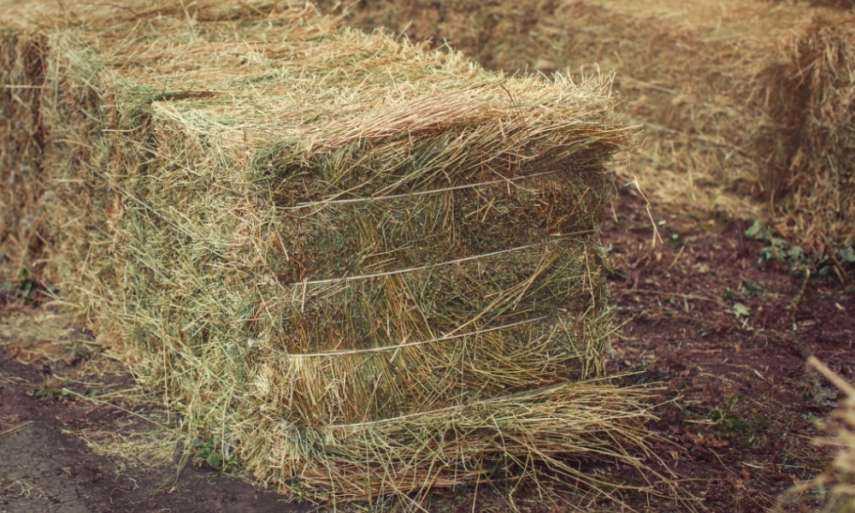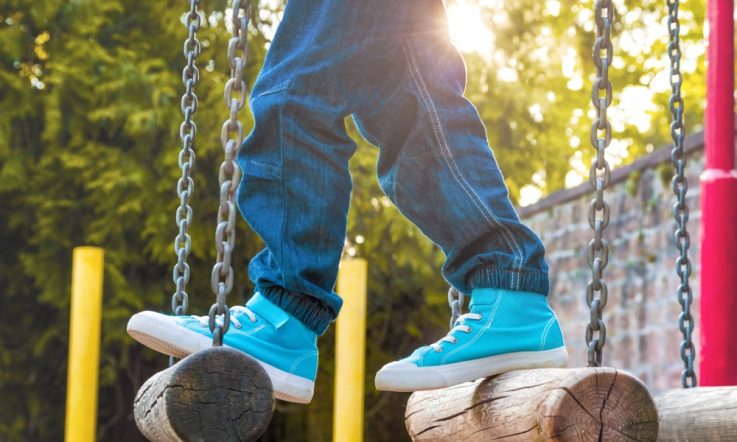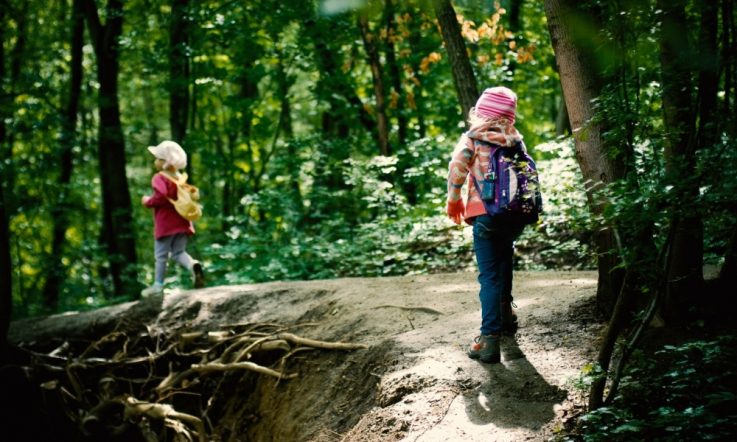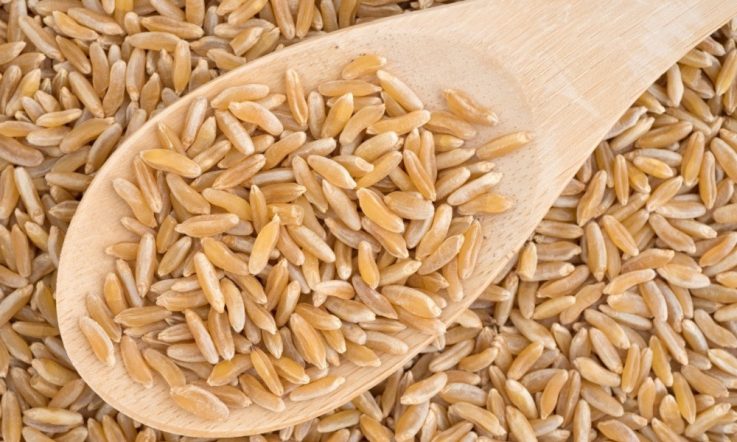- Listen to and download all the Teacher podcasts for free on iTunes and Soundcloud
Hello and welcome to Teacher magazine's monthly podcast The Research Files – I'm Jo Earp.Today, I'm talking to Dr Brendon Hyndman, a lecturer in the School of Science and Health at the University of Western Sydney. At RMIT University, he led a two year study with colleagues [Dr] Amanda Benson and [Associate Professor] Amanda Telford into the benefits of different kinds of primary school playground equipment. The results of the study have been published in the journal BMC Public Health, and the follow-up evaluation in the Australian Journal of Teacher Education.
Jo Earp: Dr Hyndman, thanks for taking the time to talk to Teacher magazine.
Brendon Hyndman: It's great to be on.
JE: I'd like to start by asking you firstly to explain, if you can, the aim of the research study.
BH: The aim of the research study was to evaluate the effects of movable recycled materials into the school playground and really comparing the effects of this over a school year with a traditional type playground, with fixed playground structures. The first aim was to evaluate these effects in relation to children's physical activity, their quality of life, and their enjoyment of physical activity over an entire school year – and comparing that, to the children at that traditional fixed school playground. After this, we also wanted to look at how transferable and feasible this would be in other school environments. So, what we did, we interviewed the teachers in this introduced school playground – seeing how they actually felt about the items over that school year; looking at the effects on children's engagement in activities; looking at some of the policies that they introduced and that type of thing. In addition to that, we also did a two-and-a-half-year follow up. We went to that new playground after two-and-a-half-years to see if some of the effects were being sustained, or not sustained.
JE: Can you summarise where this research took place and exactly what happened?
BH: The research was conducted in Ballarat [Victoria], and it was conducted at a brand new Catholic co-educational primary school, a brand new campus there. What actually occurred, the measurements were taken at baseline without any equipment out on the school yard, and children's activity was measured via pedometers - we actually measured their steps and distance covered throughout the school year. We also measured children's activity intensities and activity types via a direct observation instrument. In addition to that we got the children to self-report their enjoyment of physical activity and got them to self-report their quality of life; this was before the introduced playground, after the introduced playground and again at the end of the school year. This was compared against children in that traditional fixed playground environment. Then we also went back at two-and-a-half-years, once again, to see if that was sustained. So, the intervention itself consisted of ... week one we introduced five everyday objects – things such as milk crates, hay bales, swimming noodles, buckets and those type of household everyday items. Each week for 13 weeks there was a minimum of one of two items introduced after week one [and] by the end of the 13 weeks there was actually a lot of everyday equipment in the school playground for the children to be able to use how they actually desired. So, it was very student directed and they could direct their own play behaviour rather than putting in equipment which is adult designed and adult directed and might have less purpose that students can actually manipulate and direct their own play with. That's really a summary of how we approached introducing that playground.
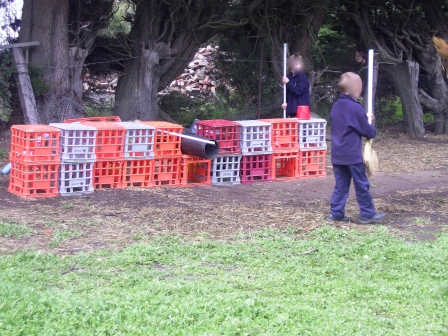
[Students patrolling a homemade fort. Image supplied]
JE: It sounds like an interesting comparison between the two environments. Can you take our listeners through three of the key findings of the study?
BH: The major finding, from the overall project over two-and-a-half-years was [related to] physical activity. First of all, in that one year comparison, compared to that traditional fixed type playground, children at school, steps and distance actually increased in the children that used the everyday objects – compared to that other school. That was found over the entire school year. Also, children were actually engaged in higher intensity activity – compared to children using that other traditional fixed type playground. And, looking over the two-and-a-half-years, in the introduced playground children's sedentary behaviour – so their sitting and standing in the school yard - actually halved. It actually dropped from 61 per cent to 30.5 per cent of children that were sitting and standing in the school yard, over that two-and-a-half-year period. Also of note, there were some short-term effects. Children [at the introduced playground school] self-reported their physical functioning actually increased compared to the [children] at the traditional fixed type playground - in the short-term after the items were introduced. Children's enjoyment of physical activity also was found to have short-term effects compared to children at the fixed type playground school. Then, what we did to evaluate the transferability and the feasibility of introducing this to other schools, focus group discussions were conducted to access teacher perceptions of how this would work and some of the effects. First of all there were a lot of individual effects on the children from introducing this type of playground: children were seen to be a lot more excited going out to play; they would enter their classrooms after lunchtime and would still be talking about what they did during that play; they were a lot more engaged, they were using the space a lot more readily, so, taking these materials out - and that could be one influence on how physical activity actually increased; they were solving problems and using their creativity skills - which I can also talk about how the children use all these objects to be creative in the school playground. There were a range of social effects as well: children were seen to be negotiating items with other children, which is quite a higher order thinking skill; they were modelling behaviour on others, so they could actually see how children were playing with some of the equipment and then being able to join in (so it was a lot more inclusive, they were able to see how some of the children used some of the equipment); and they were really working together, using teamwork skills and creating these different objects and structures and stations to play around in the school playground.
JE: Can you explain a little bit more about how the students used the different kind of materials, the everyday materials?
BH: First of all, I have to say, the milk crates were really good building blocks; so they would be building houses and spaceships, cars, castles, rockets and climbing over them and that type of thing – so they were huge. Children that enjoyed the sporting type activities would use the milk crates for soccer goals or whatever it may be as well. There were a range of other creativity benefits of using the items as well. Tyre tubes would be used for jumping, stacking and rolling around, there would be tarpaulins being used for roofing, walls and sails. Swimming noodles, children would ride around the playground, pretend they were riding horses, or being in a Harry Potter movie, and there would be tug-of-war and that type of thing with the swimming noodles. One of my favourites was the sand shells - the children would actually create like a sleigh, a toboggan, and run the sleighs down the hill. So there was actually a bit of a line up for that activity. And a whole range of different tyres and Hula Hoops for rolling around, and all the materials would be used for obstacle courses ... yeah, it was quite fascinating. What was fascinating was, when we introduced play balls, rather than using them to play structured ball games, they actually used them a little bit more for cannon balls and even groceries and that type of thing in their pretend shops.
JE: What are the implications of this research for educators and schools?
BH: It's definitely a low cost, low burden strategy to really enhance school playgrounds and especially for those schools that do have shrinking budgets and are looking to save money - rather than spending thousands of dollars on fixed type school playground equipment. This actually shows that there are a range of benefits that we found to introducing everyday objects that are quite cheap and feasible to implement, and it actually engaged children by increasing their physical activity levels over a substantial time. This is quite important as, children aged nine to 13, actually 40 per cent of them aren't meeting the recommended physical activity guidelines – which is one hour of moderate to vigorous physical activity each day. So, by engaging children's physical activity participation this will hopefully track into secondary school and adolescence and really try and counteract some of those diseases that can occur later on.
JE: Finally then, what will the next steps be in terms of research in this area and teacher action?
BH: I think, with the ranges of creativity benefits, social benefits and how engaging this type of strategy is, I think there's a lot of scope to transfer this into the home environment ... and that this type of learning is actually enhanced beyond the school environment as well. With this type of research, there's potential to either replace or complement the traditional fixed type playgrounds. With those shrinking budgets out in schools, I think this really should be trialled on a [range of] wider school[s]. By creating that variety into school playgrounds, it provides that option for children that prefer those less structured and competitive type activities, and potentially looking at moveable objects within the secondary school setting.
JE: Excellent. Dr Brendon Hyndman, thanks for sharing your work on The Research Files.
BH: Thanks for having me on Jo, cheers.
For more information about this podcast, and to access other articles and videos - visit www.teachermagazine.com.au, or join our community on social media via Facebook and Twitter.
What everyday items could you introduce to your school playground? Have you asked students about the kinds of equipment they'd like to see being offered?
To read more about this research visit https://uws.academia.edu/BrendonHyndman or chat to Dr Hyndman directly on Twitter via @dr_bph
